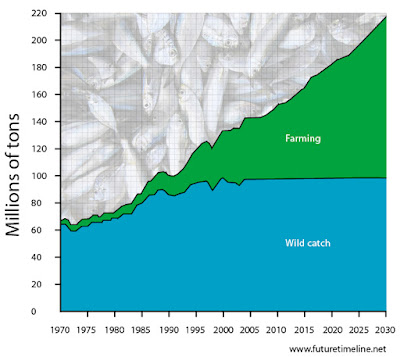Aquaculture – protein provider for the world
During the 1970s aquaculture was a relatively insignificant industry, but today it is almost as productive as the ocean fishing sector. About 600 aquatic species are now raised in captivity, with different species being preferred for different regions. Experts predict that the importance of fish farming will increase even more in the future, because it has clear advantages over beef and pork production.
Towards more eco-friendly aquaculture
Aquaculture is expected to satisfy the growing world population’s demand for fish – and at the same time protect ocean fish stocks. Hopes are pinned on farming as an alternative to over-fishing. But the use of copious amounts of feed derived from wild fish, the destruction of mangrove forests and the use of antibiotics have given fish farming a bad name. Current research and development projects, however, show that environmentally-sound aquaculture systems are possible.
Aquaculture
sector predicted to be increasing in year 2030 and provide majority of the
world’s seafood
Problems / Issues of Aquaculture
Aquaculture, like any other industry, has its costs and benefits, as well as its proponents and opponents. As a result, there are impediments to aquaculture development in the world. Some of the concerns expressed about aquaculture are valid, while others are steeped in misconceptions and misunderstandings about the nature of aquaculture.
1)
Fish feed requirements
Farmed carnivorous fish, such as
salmon, require a food source which is high in fish-derived proteins. This generally
comes from wild capture fish at the bottom of the food chain, which are not
usually marketed for human consumption.
There are two key challenges to developing a sustainable aquaculture
industry. The first is to find a source of food for the farms which does not
depend exclusively on wild fish being caught. The second is to ensure that any
wild fish used as feed is caught in a sustainable manner. This is because
removal of these species low in the food chain can have serious implications
for fish stocks, the food web and other wildlife including sea mammals and
seabirds.
2)
Sites in vulnerable habitats
There are a number of problems
which stem from fish farms being located in inappropriate areas. These include
vulnerable habitats (both terrestrial and marine), essential fish habitats or
areas with high concentrations of wild fish. Some of the problems can include
organic waste accumulation on the seabed under sea pens – resulting in
localised degraded water quality sea lice and other disease transfer; and
altered food webs from escaped individuals as described below.
3)
Escapees
When fish escape from a farm open
to the sea, this can lead to problems for the wider ecosystem. This is because
escaped farmed fish can interbreed with wild fish of the same species,
resulting in genetic dilution (domestic farmed fish can have low genetic
variation); they can spread disease; they can displace eggs of wild fish and
they can put pressure on natural resources through competition with wild fish.
4)
Pollution
A range of chemicals can be used
in marine aquaculture operations such as disinfectants, anti-foul ants and
medicines (including vaccines). These marine pollutants can be toxic to
wildlife and can cause significant damage to the wider ecosystem, especially
anti-foul ants containing copper.
Fish welfare can suffer in an
intensely farmed environment where the stock density (the weight of fish kept
in a given volume of water) is too high. Fish welfare concerns apply to the
farming, transport, and harvesting and slaughter process. The RSPCA has useful
information on issues affecting fish welfare. Sea fish farms need to be better
located in appropriate sites to avoid natural predators becoming a problem in
the first place. The aquaculture industry would benefit from technological
developments that prevent fish loss from predators without affecting the
predator populations or their roles in ecosystem health.

No comments:
Post a Comment